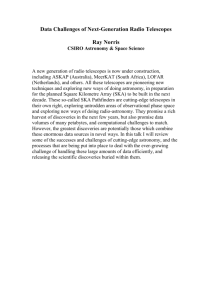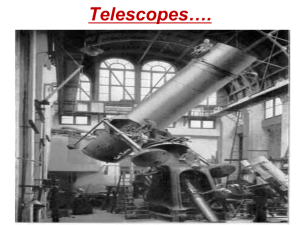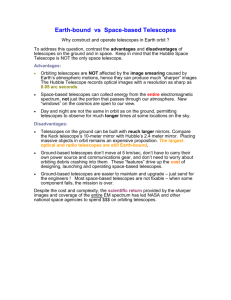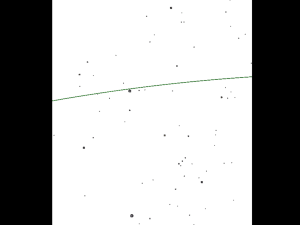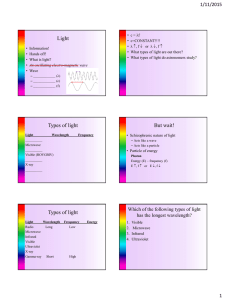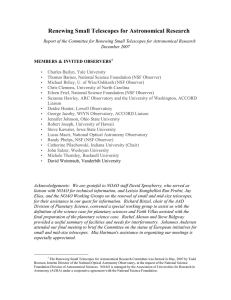TELESCOPES
advertisement
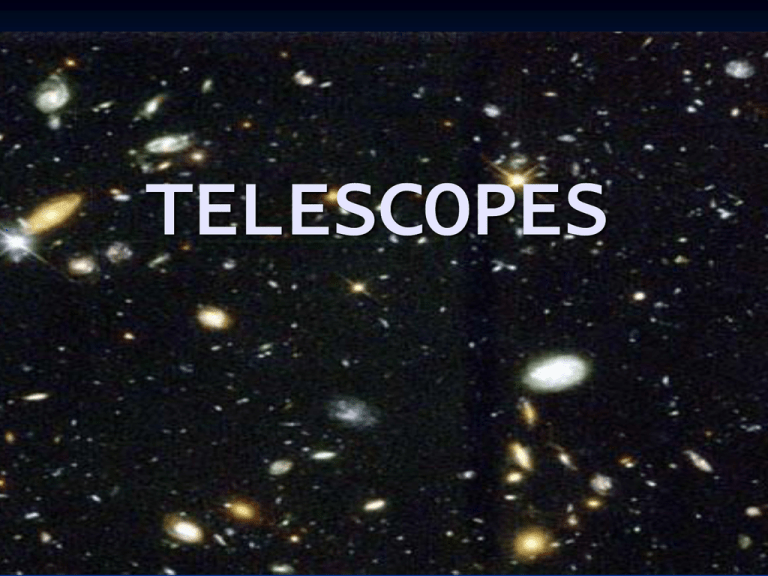
TELESCOPES Telescopes Write what is in YELLOW You will be accountable for text in yellow on quizes. Where do we put telescopes to have the best viewing conditions? 1. On Earth: CLEAR HIGH DRY COLD DARK Problem with Telescopes on Earth? Problem: Particles of all sorts in the atmosphere block and cloud the view 2. In Space Solves atmosphere problem – CLEAR VIEW! Examples: Hubble, Cobe , Iras Problem with telescopes in space? They’re in space! Hard to get to Hard to repair EXPENSIVE!!! Functions of a Telescope 1. 2. 3. 4. Collect Light Magnify Images Separate Distant Objects Use as a Camera I. OPTICAL TELESCOPES (USE VISIBLE LIGHT) Two types: 1. Refractor – BENDS LIGHT Invented by Hans Lippershey in 1608 Refined by Galileo in 1609 Galileo demonstrating his telescope Tololo Observatory - Chile TYPE 1 – REFRACTING TELESCOPE How does it work? a. b. It bends light to create an image It uses two lenses 1. eyepiece (ocular) lens - small 2. objective lens - large Draw it! Type 2 – Reflecting Telescope a. Invented by Isaac Newton in 1668 b. Uses two mirrors Objective Mirror – Large Secondary (flat) mirror – Small c. Can be VERY LARGE 40 ft - 50 ft diameter objective mirror! 2. Reflector – USES MIRRORS Cheap and common Draw It! Most Modern Telescopes combine technologies A. Examples a. b. Hubble Kepler http://kepler.nasa.gov/ Advantages of a reflector 1. only one side of the mirror. A. 2. (on a refractor the lens has two sides) – cheaper and distortion is less of a problem. The whole back of the mirror can be supported, therefore can be made very LARGE II. Non-optical Telescopes 1. Radio Telescopes a. Location – Earth (atmosphere does not affect radio waves) b. Structure – Large metal dish c. Size – very large because radio waves have a very long wavelength d. Arrays – sets of multiple radio telescopes that allow for more data to be gathered. Ex – VLA (very large array) in Socorro, New Mexico 27 dishes. SETI– Search for Extra-Terrestrial Intelligence looking for intelligent radio signals Other Non-Optical Telescopes (all are satellites) 2. Infrared – IRAS launched 1983 3. Microwaves – COBE Cosmic Background explorer. Discovered evidence of the Big Bang. Launched 1981 COBE Image of CBR 4. X-Rays – Chandra Launched 1999 Cassiopeia Super Nova Black Hole Crab Nebula Saturn 5. Gamma Rays – Observatory GRO Gamma Ray Milky Way


